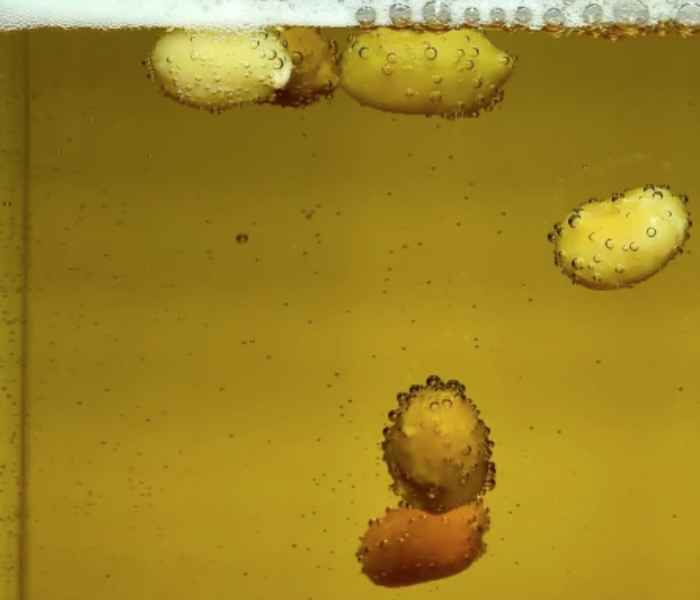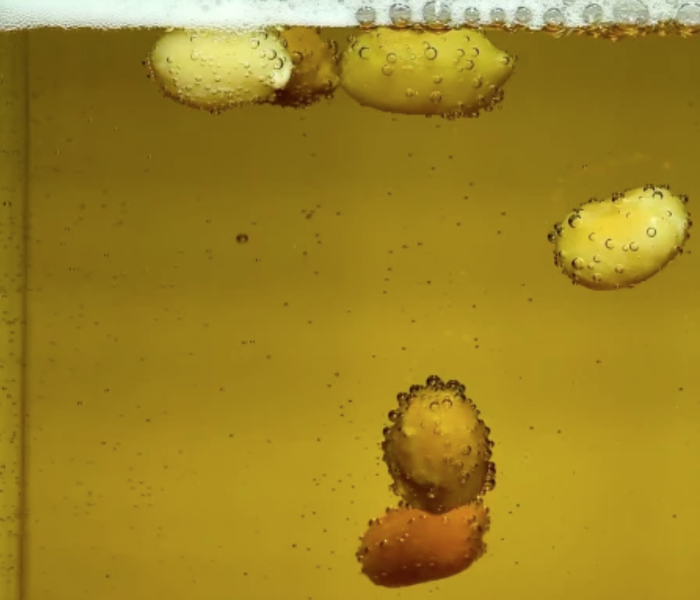Beer-Dancing Peanuts Explained
In Argentina, it is common for a bartender to entertain a patron with a “dancing” peanut. Placing a beer down in front of a patron, the bartender drops a peanut into the bubbly liquid. The peanut sinks because the legume is denser than the liquid around it. But then the peanut starts to rise, floating to the beer’s surface. The peanut then sinks and rises again, continuing in this cycle until the patron gets bored and drinks their beer. Researchers now have a physical description for this amusing bar trick, which has commonalities with processes that occur in Earth’s magmas [1].
For their experiments, Luiz Pereira of the Ludwig Maximilian University of Munich and colleagues dropped whole, shelled, roasted peanuts into a 1-liter tank of lager-style beer. They then recorded the peanuts’ motions using a camera.
The videos show that as soon as a peanut entered the liquid, gas bubbles started attaching to its surface. These bubbles continued to accumulate after the peanut had sunk until there were enough to float the peanut to the surface of the beer. When the peanut reached the surface, it started to rotate around its long axis, causing the bubbles to burst and their buoyant air to dissipate. Once a large enough fraction of the bubbles had burst, the peanut lost its buoyancy, sinking again. In one liter of beer, this process took as little as a few seconds and repeated for an average of 150 minutes until the peanut sinks for good.
The researchers modeled the process, finding that it is energetically favorable for bubbles to nucleate on the surface of the peanut rather than on the glass or in the liquid. This favorability comes from the relatively high contact angle the surface of the peanut provides for bubble nucleation.
Michael Manga, a planetary scientist at the University of California, Berkeley, says that the motion of the beer-dancing peanuts could aid in understanding gas-induced processes in other systems, such as in Earth’s crust, that are difficult and dangerous to probe experimentally. The surfaces of liquid-magma regions of Earth’s crust are often decorated with magnetite, the crystallized mineral form of magma. As a solid mineral, magnetite is denser than liquid magma, so why does it float? The leading explanation for magnetite’s buoyancy is that it comes from gas bubbles in the magma attaching to the surface of the mineral, causing it to rise.
Once it has risen, magnetite crystals don’t then sink, as is the case for the peanuts. But Manga—and Pereira—think that beer and peanuts could allow researchers to get a safe, up-close look at how the bubble-nucleation and degassing processes might work in magma. The process of how bubbles nucleate on the surface of an object is something scientists don’t fully understand, Manga says. “[Bubble nucleation] is a phase transition where you go from one state to another, and all phase transitions involve nontrivial physics,” he says.
Pereira says that he and his colleagues are now testing how different beer types and different peanut styles impact how a peanut dances. For example, Pereira says that in a highly carbonated beer, such as a craft beer, the peanuts stay bobbing at the surface for longer than they do in a less carbonated beer, such as the lager they used for their experiments. That is because bubbles continue to accumulate on the peanut when it is at the surface and do so at a rate almost as fast as that with which they disappear. Meanwhile broken peanuts seemingly float forever, as they rotate less easily and so can maintain their bubble-flotation aids.
–Allison Gasparini
Allison Gasparini is a freelance science writer based in Santa Cruz, CA.
References
- L. Pereira et al., “The physics of dancing peanuts in beer,” R. Soc. Open Sci. 10 (2023).





